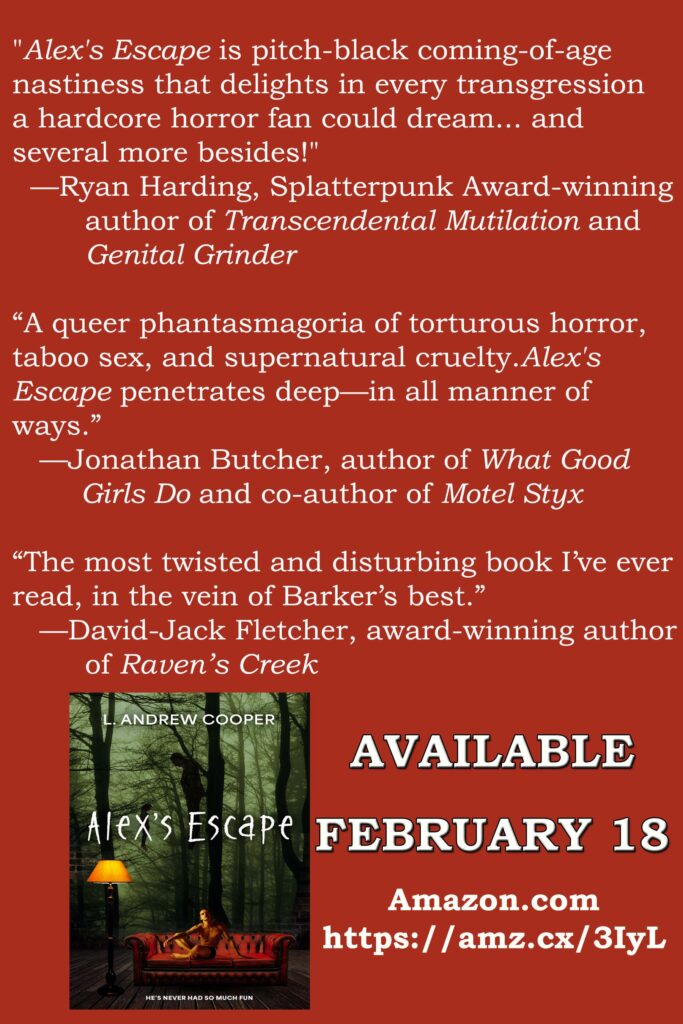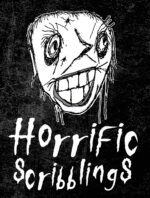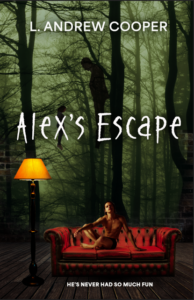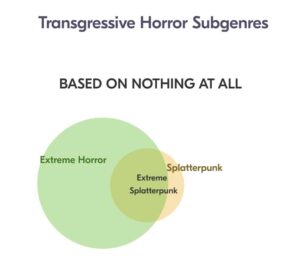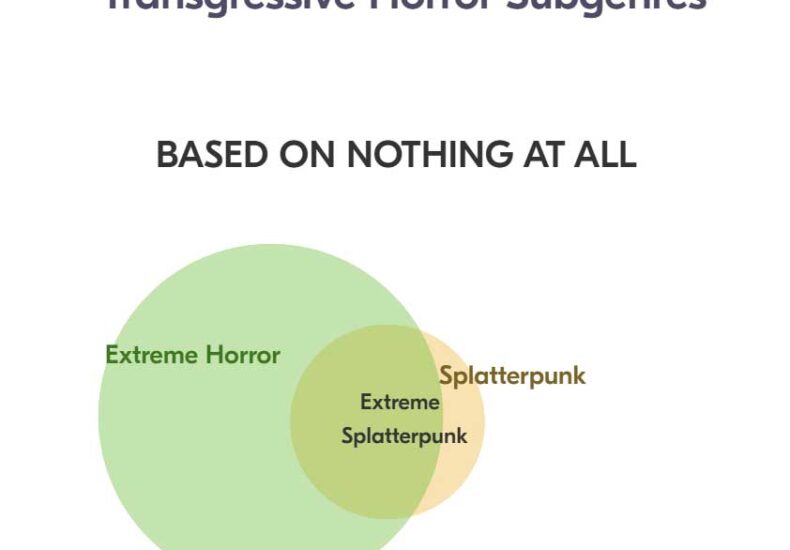
Alex’s Escape: Why I Wrote Such Horrific Filth
by L. Andrew Cooper
With my novel Alex’s Escape, I set out to write a sick, twisted, deplorable, outrageous work of horror that would stand out among other sick, twisted, etc. works of horror. If the limited pre-release feedback I’ve received is any indication, I have succeeded.
ARC (advance reader copy) reviews on Goodreads hold back some coveted stars but all have nice (according to me) things to say. Sample comments (all from different reviews) include “the perfect splatterpunk that I needed,” “excellent bone-chilling splatterpunk,” and three superlatives. My personal favorite is “one of the most brilliantly written stories I’ve had the pleasure of reading,” but that’s for my general ego. More germane are the reviews that call Alex’s Escape “the most disgusting book I’ve ever read” and “the darkest horror I’ve ever read.” Wow.
These reviews are from people who chose the book knowing it is extreme/splatterpunk and seeing that I’d clicked almost all the trigger categories available on the website of the ARC distribution service, BookSirens. Wow.
Two of the three authors who wrote early blurbs for Alex’s Escape (their blurbs are here), authors who have written some extreme fiction themselves, took confidential moments to warn me that Alex’s Escape could be too extreme, or at least extreme in the wrong ways, and therefore asking for trouble. I had to tell them I’d figured as much.
But what’s the point of transgressive fiction that isn’t transgressive? I don’t think you can be transgressive without asking for trouble, and splatterpunk–which is really what I wanted to write, and what Splatterpunk Award-winning and -nominated authors (as well as the Goodreads reviewers I’ve quoted) say I’ve achieved–is transgressive. It’s punk, which is to say aggressively attacking political and cultural norms and assumptions, with splatter, which is to say boundary-pushing depictions of violence.
Why would I want to enter the world of Splatterpunk? (NB: I never know whether to use the capital S.)
In one way, I’ve been in it a very long time. I started on Clive Barker around age 12 without knowing his work was or would be declared splatterpunk; I read Poppy Z. Brite in my teens and especially loved Exquisite Corpse. I read Jack Ketchum’s The Girl Next Door around 2004, and Ketchum immediately became one of my literary heroes. My second published novel, Descending Lines (first drafted 2004, first published 2014) I knew to be “extreme,” though I didn’t know how big the “extreme horror” subgenre was when I wrote or when I published it. I think it also qualifies as splatterpunk. Its splatter is quite punky.
As a side note, many authors argue vehemently for distinction between extreme horror and splatterpunk. After some study and discussion with people whose work generally receives those labels, I’d say they’re categories with different emphases that overlap, as in a Venn diagram. Some works of extreme horror are not splatterpunk and vice versa, but many are both.
So… anyway… years after I published Descending Lines, I started doing a bunch of new interviews on my personal website, and Hal Bodner, whom I knew from Reel Dark, an anthology I co-edited, connected me with Monica J. O’ Rourke, calling her the “queen of torture porn.” I was, of course, intrigued, and I not only interviewed her, but I read everything by her I could find and discovered that she and her work are brilliant. She recommended more writers to me, and those writers recommended more writers, and suddenly I discovered a vastness of extreme writing and learned about a splatterpunk community.
This! This is what I’d been looking for!
While I delved into this new, messy realm, I also heard more about a new wave of queer horror, new queer extreme horror, new queer splatterpunk… not much of which I’ve seen, to be honest… but I figured, if I’m going to be punky and splattery, since I am queer, I might as well be queer. I tried to imagine what queer splatterpunk would look like if I wrote it.
The lowest-hanging fruit was torture porn motivated by queerphobia, ideas about which I tried to channel into my collaboratively written novella Records of the Hightower Massacre, but the nature of the collaboration led to an emphasis on overt politics rather than transgressive violence. You should totally read it (and/or listen to the fine audiobook), but don’t expect queer splatterpunk. It’s more like LGBTQ-affirmative horror with some very nasty bits.
Alex’s Escape, on the other hand, doesn’t affirm anything. It is dark to the point of nihilism. I decided that if I was going to be transgressive, I would go full dark, abandoning taboos I’d previously observed related to sexual violence and age restrictions and whether the politically oppressed could look like bad guys. I thought of a queer issue, gay adoption, and thought of a way to make it horrifying–what if two gay men adopted a teenage psychopath? What if the boy, charming and manipulative, said he was gay, too?
What if the boy had supernatural forces eager to provide the help, encouragement, and protection he needed to ravage and kill people in the most extravagant ways he could imagine?
I could center the story on the boy… a darker coming-of-age story than any I’ve encountered, possibly the darkest…
My speculation produced a framework for unbounded depravity. Alex’s Escape is a tough book to read, built to satisfy those who seek transgression but not to please crowds (except, perhaps, those in bloodthirsty arenas). I built it because I want to be part of a tradition that has inspired me for a lifetime, even though I didn’t always know about the tradition itself. I built it because I believe in the cause of Splatterpunk, attacking cultural norms and assumptions, and savor its methods, transgressive representations of violence.
I’m not saying that Alex’s Escape is a derivative mirror of subgenre cliches. In fact, I’d say its supernatural and surreal qualities make it quite unlike most stories that claim to be splatterpunk, so much so that people might dispute giving it the label. It is my sort of story first, other sorts of story later.
Nevertheless, artists and works that wear the splatterpunk label inspired me to see how far I could go with explicit–very, very explicit–taboo-breaking, norm-tumbling horror that would deserve to be called queer. Their inspiration is why I wrote Alex’s Escape. I have other reasons… ideas I wanted to get across… a story to tell that would stand up (though not as well) without the gore… but testing limits was probably the main one.
Why did I write such horrific filth? Because I wanted to join a growing tradition of horrific filth by doing an experiment, with both thought and emotion, to show how horrific and filthy I could stand to be while still delivering a high-quality, meaningful story written in careful prose. Now I await the fallout.
If you’d like a signed copy of my horrific filth, please visit the shop.
